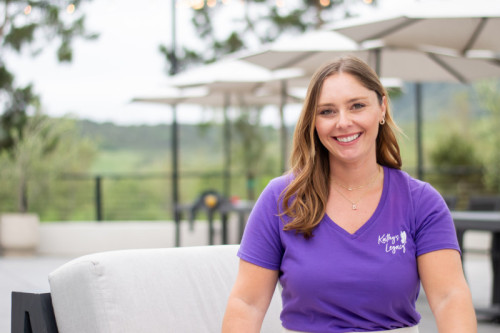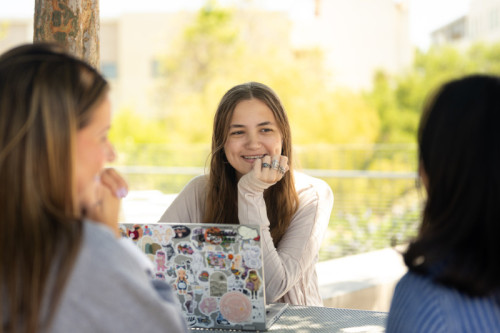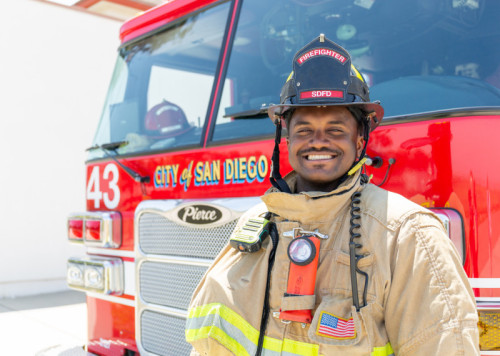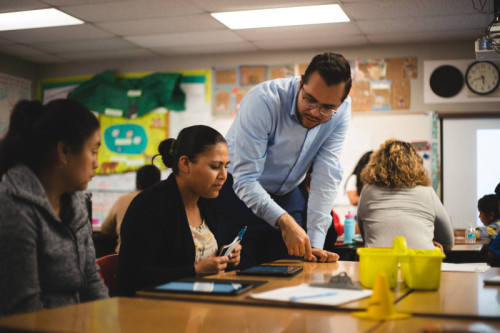Celebrate gAyPRIL With Nearly Two Dozen Events
In celebration of gAyPRIL, Cal State San Marcos’ Pride Center is partnering with campus organizations to present an exciting lineup of events.
Everyone is invited to participate in the following events:
Queer Gaming Spotlight
April 10, 1-2 p.m., USU 3100
Discuss new games and recently released updates.
Polyamory Meetup
April 10, 4-6 p.m., USU 3100
Discuss your experiences with polyamory and meet other people in the community over snacks and a puzzle.
Queer Cinema
April 10, 6-8 p.m., USU 3100
Take part in a discussion about films pertaining to the queer community through a critical media lens.
Neutral Ground
April 11, noon-1 p.m., USU 3100
Students are invited to safely talk to each other about difficult questions on their daily affairs, sexual orientations, relationship choices and more.
Queer Cinema
April 12, 6-8 p.m., USU 3100
Take part in a discussion about films pertaining to the queer community through a critical media lens.
History of Drag and Ballroom Culture
April 13, noon-1 p.m., USU 3100
Learn about the history and foundations of drag and ballroom culture, focusing on the influential people and demographics that built the LGBTQIA+ community up through their fights throughout history. Historically, the Black community and transgender women have played some of the most impactful roles in creating the world we live in today.
Queer Disney
April 13, 6-8 p.m., USU 3100
Join the conversation on Disney films pertaining to the queer community and participate in a matching coloring activity.
Cookies and Queers
April 17, noon-1 p.m., USU 3100
Queer Gaming Spotlight
April 17, 1-2 p.m., USU 3100
Discuss new games and recently released updates.
Queer Cinema
April 17, 6-8 p.m., USU 3100
Take part in a discussion of films pertaining to the queer community through a critical media lens.
Monkeypox Presentation
April 18, noon-1 p.m., USU 3100
Vista Community Clinic returns to campus to educate the CSUSM community about monkeypox and how to reduce the spread.
Intersectional Gaming Mixer
April 19, noon-1 p.m., USU 3100
Connect with the CSUSM gaming community.
Queer Cinema
April 19, 6-8 p.m., USU 3100
Take part in a discussion about films pertaining to the queer community through a critical media lens.
Queer Disney
April 20, 6-8 p.m., USU 3100
Join the conversation on Disney films pertaining to the queer community and participate in a matching coloring activity.
Queer Gaming Spotlight
April 24, 1-2 p.m., USU 3100
Discuss new games and recently released updates.
Trans 101
April 24, 2-4 p.m., USU 3100
Vista Community Clinic will present the different types of hormone replacement therapy (HRT) and the medical side of transitioning. An open session will take place after the presentation to discuss what it's like to be on HRT.
Queer Cinema
April 24, 6-8 p.m., USU 3100
Take part in a discussion about films pertaining to the queer community through a critical media lens.
Off to the Races
April 25, 10:30-12:30 p.m., USU 3100
Learn about “RuPaul’s Drag Race” and its representation of drag culture around the world.
Listening with Pride
April 26, 5-6 p.m., USU 3100
Come by and listen to a variety of queer music artists with intersections of identities.
Queer Cinema
April 26, 6-8 p.m., USU 3100
Take part in a discussion about films pertaining to the queer community through a critical media lens.
Queer Disney
April 27, 6-8 p.m., USU 3100
Join the conversation on Disney films pertaining to the queer community and participate in a matching coloring activity.
Rainbow Recognition and 15-Year Celebration
April 28, 5:30 p.m., USU Ballroom
Rainbow Recognition is our annual celebration of our LGBTQIA+ students that will be graduating spring, summer and fall 2023. Students earn a rainbow cord and stole, which will be presented by our LGBTQA Faculty Staff Association. This year, we will also be celebrating the 15-year anniversary of the LGBTQA Pride Center.
Media Contact
Eric Breier, Public Affairs Specialist
ebreier@csusm.edu | Office: 760-750-7314
Latest News Release
- Attend Campus Webinar for Information on AB 481 Regulated Equipment ReportAs part of the university's commitment to transparency and open communication, the University Police Department (UPD) will host a webinar at noon on Thursday, Oct. 30 via Zoom https://csusm.zoom.us/j/83186146403. The Zoom meeting ID is 831 8614 6403. This webinar will provide information from the annual AB 481 Regulated Equipment report. Every year, agencies must report any military equipment used as part of their operations. This webinar is open to all CSUSM students, faculty and staff. No registration is required. Additional information about UPD policies, contact information and other campus services can be accessed by visiting www.csusm.edu/police.
- MBA Graduate Builds Meaningful Career Helping Domestic Violence SurvivorsAs co-executive director of Kathy’s Legacy Foundation, Alex Lutz will tell you that no two days are ever the same. One moment she’s assembling raffle baskets, the next she’s reviewing financial statements. “It’s almost like you could take a Fully Employed MBA class schedule and go, ‘OK, yep, you’ve tapped finance, you’ve tapped accounting, marketing, leadership,’ ” Lutz said. “Somehow, I have to wear one of those hats at any given point in my job.” Founded in the wake of a tragic act of domestic violence, Kathy’s Legacy Foundation honors the memory of Kathy Scharbarth, who was murdered by her ex-boyfriend in 2011. The nonprofit supports children and pets impacted by domestic violence – offering comfort, stability and hope through its two signature programs. Lutz, who joined the organization in 2019 after earning an MBA from Cal State San Marcos, thrives on the variety and challenges of nonprofit work. Her time at CSUSM helped her develop a deeper understanding of her strengths and areas for growth, while also fostering connections that continue to support her in her role today. “CSUSM helped me focus on what I felt like my strong suits were and what I liked and didn't like,” Lutz said. “The personal connections I made at CSUSM have become invaluable professional resources.” Years after graduating, Lutz came full circle when she collaborated with CSUSM business students on their Senior Experience project for Kathy’s Legacy. Although the project was ultimately cut short due to the pandemic, Lutz felt a strong connection to the students because she had completed similar projects while earning her MBA. “The project was marketing-focused, and we were working to try to reach donors who resonate with our mission, " Lutz said. “I was bummed that we didn't get to finish in person together, but I loved getting to work with them as someone who has gone through the same experience. It was great, and we got some amazing materials in return.” Lutz first connected with Kathy’s Legacy when a friend asked if she’d be interested in consulting on an event for the organization. She was immediately drawn to the mission and soon after was hired full time as a program manager. In the ensuing years, she steadily took on more responsibility, stepping into the role of co-executive director in 2024. “I feel like jumping in wholeheartedly and putting everything I had into Kathy’s Legacy led me to where I am today," Lutz said. The foundation’s work centers on two initiatives: the Silver Lining program, which helps children heal from the trauma of losing a parent to domestic violence, and the Lady’s Legacy program, which was inspired by Scharbarth’s yellow labrador, Lady, who was present when Scharbarth was killed. Lady became a symbol of the often-overlooked impact of domestic violence on pets. Lutz now helps coordinate multiple fundraising events throughout the year, including the annual Kathy’s Legacy Golf Tournament held at Twin Oaks Golf Course in San Marcos. The work isn’t easy, but Lutz says the impact is clear at the quarterly events Kathy’s Legacy hosts. There she sees firsthand how the organization is changing the lives of the children they support. “We had one boy who was not doing well during COVID and even long after the pandemic would wear a mask and have his hood up,” Lutz said. “But in the past year, the hood has come off and he’s smiling and engaging, which means something we’re doing is working. “I love that we can be that beacon of light and that reliability that these kids don't have anywhere else.” Media Contact Eric Breier, Interim Assistant Director of Editorial and External Affairs ebreier@csusm.edu | Office: 760-750-7314
- Chronic Illness a Journey of Strength, Self-Discovery ... and SaltThe first time I rode in an ambulance was in May 2024. I was in the middle of my 10:30 a.m. Communication 200 class when I realized my vision and hearing were failing. I couldn't keep my legs or arms straight and I couldn’t speak. The full memory is hazy, but I found myself sitting outside of Crash’s Market in the University Student Union with a handful of salt packets and on a Facetime call with my parents, who live in Tennessee. This experience didn’t come out of nowhere. I have postural orthostatic tachycardia syndrome, or POTS, a chronic condition that I’ve lived with since my junior year of high school. There’s not a lot known about POTS, but it's a disorder affecting the autonomic nervous system. When I switch positions (postural) – especially when I go from sitting to standing upright (orthostatic) – my heart rate rapidly increases. On average, it's over 100 beats per minute (tachycardia). POTS leaves me with a slew of symptoms. Daily, I experience dizziness, nausea, fatigue and brain fog, among others. Some people who have POTS faint frequently, even daily. I'm lucky enough that this doesn't typically happen to me, but I do experience presyncope, which means I go through all the symptoms of passing out while still fully conscious. When it occurs, I'm not able to see, speak or hear anything. I’m so dizzy I can’t walk straight. I get heat flashes. I remember only bits and pieces of what happens during these moments. The severity of my symptoms can vary, leading to an episode like the one I suffered in May 2024. If I have been walking or standing for too long, sitting for too long, am stressed out or if it’s hot outside, there’s a higher chance of an occurrence. That day in May, while I was on the phone and sitting outside of Crash’s Market, my parents called the paramedics. Determining that I couldn’t walk anywhere on my own and wouldn’t be able to for several hours, they took me by ambulance to the emergency room at a nearby hospital. Though it was my first time in an ambulance, I had made frequent visits to the ER over the previous four years. The process this time was the same as it had been for prior trips: They measured my vital signs, checked my heart with an electrocardiogram and did blood work to confirm POTS as the reason for the incident. Then I received an IV. IVs have been incredibly helpful. People with POTS struggle with low blood volume and tend to get fewer nutrients from the food we eat. An IV provides quick hydration and extra electrolytes. I also constantly consume extra salt, which helps improve blood volume. I add salt to my food, but in extreme cases, I will just eat plain salt packets. At restaurants, I always take an extra handful of salt packets from the condiment stand. These live in my purse or backpack, and I keep them handy in case I feel an episode coming. Some of my friends even carry salt packets when they’re hanging out with me. Despite the challenges, I try to focus on the positives. This journey has taught me to advocate for myself and surround myself with people who care about me, which is easy to do at Cal State San Marcos. Self-advocacy became a necessity as I went through many months of doctors’ appointments during high school trying to figure out what was wrong. Several doctors said everything I was going through was normal. But I knew it wasn’t. I wasn’t officially diagnosed with POTS until two years after my first symptoms. I had COVID twice during that time, and doctors believe that may have exposed an underlying condition. POTS is a chronic illness, meaning there is no cure. I’m a regular at the doctor’s office, with multiple appointments every month. Attending events causes heightened anxiety – both for me and the friends I’m with – and I do my best to be prepared in case of an episode. I had to take another ambulance ride in March. A friend and I were at a Kelsea Ballerini concert in San Diego. Though I had been fine the whole day, I started feeling nauseous and dizzy during the first opening act. I couldn’t stand. By the time Kelsea took the stage, the combination of the heat, crowd and strobe lights proved too much. My friend had to help hold me up as she guided me down the stairs to find the medics. Situations like this are frustrating. I don’t want to be a burden to friends and family, and I don’t want friends constantly worrying or family having to pick up slack. I’ve made some lifestyle changes in an attempt to lessen my symptoms. I take daily medication to ensure that my body keeps the right balance of salt and water. I drink tons of water with extra electrolytes and salt added. I try to walk every day to get my body more adjusted to moving. On hot days, I carry a mobile fan. And I also make sure to eat well. When I decided to attend CSUSM, the Disability Support Services office proved invaluable – they set me up with first-floor housing so I could avoid stairs (and anyone who has spent time on campus knows it’s no easy task to avoid stairs at CSUSM!). I also have learned to be more open about my condition. Through my on-campus job as a writing intern in the University Communications office, I’ve made great friends and found people who understand and support me. The experience has been an important part of pursuing my goal of becoming a writer. While CSUSM has helped me grow, my family and I made the difficult decision for me to move back to Tennessee at the end of the spring semester to focus on my health. I’ve had my share of challenges, but I also know how difficult it has been for my family to get calls in the middle of the night to learn I’ve been taken by ambulance to the ER when they’re 2,000 miles away. Though I’m heading east to finish college, I’ll always be thankful for my time at CSUSM – for the friends I’ve made, the support I’ve received and the confidence I’ve gained in sharing my story. Media Contact Eric Breier, Interim Assistant Director of Editorial and External Affairs ebreier@csusm.edu | Office: 760-750-7314
- Soccer Takes the Stage in 'The Wolves'Cal State San Marcos Theatre brings the complexities of teenage girlhood to the stage with “The Wolves.” The play, written by Pulitzer Prize finalist Sarah DeLappe, is a coming-of-age tale that follows a high school girls soccer team as players navigate degrees of adolescence, identity and growing up. Performances of “The Wolves” will take place in Arts 111 at 7 p.m. from Nov. 12-15. Tickets for students are $10, while general admission tickets are $15. Through their interactions, rivalries and moments of vulnerability, the girls grapple with the nuances of teenage girlhood and the unspoken bonds that form within the team. Set entirely during pregame warmups, the performance captures the chaotic, overlapping conversations between players as they discuss everything from global politics to personal anxieties. To perfect the soccer moves in these moments, the actresses are being coached by Emily Mahmoud, a senior midfielder on the CSUSM women's soccer team. Media Contact Eric Breier, Interim assistant director of editorial and external affairs ebreier@csusm.edu | Office: 760-750-7314
- Firefighting Proves to Be ‘Hand-in-Glove Fit’ for GraduateDwaine Collier always has thought of himself as a guy who runs toward the frightening things that most people run away from. As a boy, his career aspiration was to be on a SWAT team. As a student at Cal State San Marcos, though his academic track early on was kinesiology, he gravitated to the theater and began auditioning for every high-pressure stage role possible. So when Collier was at a crossroads in his post-graduate life and his stepfather figure suggested that he explore firefighting, perhaps the most surprising aspect is that Collier had never thought of it himself. Who, after all, is more willing to charge headlong into a risky situation than a firefighter? “I’m the person who will stop their car on the side of a busy road to help somebody rather than driving on,” Collier said. “That’s just what I do. It’s what’s in me. So for me, this job is a hand-in-glove fit.” Collier was speaking from a common area inside San Diego Fire Station 43, which is in Otay Mesa and has been his home away from home for the past year. On this day in late April, he had donned his gear several times to go on calls in the station’s primary engine with his firehouse colleagues – a firefighter paramedic, an engineer and a captain. The calls were fairly routine. Because Station 43 is in a lightly developed neighborhood only a few miles north of the Mexico border, most of the emergencies that its crews respond to are vegetation fires, car fires and incidents at the border itself – often people sustaining injuries as they try to cross into California illegally. Collier, 29, is less than four years into his firefighting career, which translates into this current assignment far from the heart of San Diego. He has to gradually work his way up the ranks and into more plum stations. But Collier still loves where he is and what he’s doing. He gladly will show off for visitors every nook and cranny of Station 43 – from the exercise space where he gets to incorporate one of his favorite activities (weightlifting) into his work hours, to the kitchen where he frequently cooks meals for the whole house, to the cherry-red fire engine that he has come to know every inch of like the back of his hand. “Becoming a firefighter is one of the best decisions I’ve ever made,” he said. “It’s not an easy job. When the stuff hits the fan, it sprays everywhere. But it’s also one of the most rewarding things you can do.” It was at CSUSM that Collier discovered the stability and self-confidence that made life as a firefighter seem realistic. He grew up in the foster system and entered the university having attended an astounding 17 different schools before he even reached high school, Olympian in Chula Vista. He arrived at CSUSM with the assistance of ACE Scholars Services, the university’s program for former foster youth. Collier switched his major from kinesiology to visual performing arts and threw himself into theater with abandon, ultimately starring in seven shows during his five years as a student. “What CSUSM gave me is the belief that I can do anything,” said Collier, who graduated in 2018. “I came into college with extreme educational deficiencies. Yet CSUSM had every tool to catch me up and help me succeed. It gave me the environment to grow.” Collier intended to pursue a Master of Fine Arts and a doctorate en route to becoming a theater professor, but he admits that he didn’t prepare well enough for his graduate school auditions and was delivered a harsh “reality check.” He was teaching kids at Callan Swim School when his stepdad proposed what turned out to be a fateful visit to the Heartland Fire & Rescue station in El Cajon. He was a reserve firefighter there for a year before entering the San Diego Fire Academy in 2022. Now Collier aims to keep climbing the ladder – both literally and figuratively – as a firefighter while not pulling it up behind him. As soon as he joined the fire service, he got involved with community outreach as part of the team tasked with recruiting the next generation of firefighters. And his next goal is to take classes toward becoming an instructor of young firefighters eager to enter the fire service. “I feel like that’s my next calling,” he said. “I’m trying to figure out how to give back by motivating and helping others. It gives me joy to see people be uplifted and accomplish things.” Media Contact Brian Hiro, Communications Specialist bhiro@csusm.edu | Office: 760-750-7306
- $10,000 Stipend Available for Student Teachers in CaliforniaStudent teachers across California now have access to a new financial support program aimed at easing the burden of unpaid teaching hours required for credentialing. Signed into law on June 27, Assembly Bill 121 (AB 121) established the Student Teacher Stipend Program, which provides $10,000 stipends to eligible student teachers who complete at least 500 hours of student teaching. The program, which will go into effect for student teachers in the 2026-27 academic year, is designed to support future educators and strengthen the state’s teacher pipeline. The initiative is funded through the California General Fund, with $300 million allocated for the 2025-26 fiscal year. Beginning in 2026-27, up to $100 million annually may be made available, depending on future state budget appropriations. The stipends will be available to local educational agencies (LEAs) – including school districts, charter schools and county offices of education – that host student teachers, teacher residents or apprentices. Intern credential holders are not eligible. The program is non-competitive, meaning all eligible LEAs that apply will receive funding, subject to availability. LEAs apply through a streamlined online process managed by the Commission on Teacher Credentialing (CTC). In addition to supporting student teachers, LEAs may use stipend awards to offset wages for apprentices or support residents not funded through other residency programs. LEAs can apply through the CTC’s online portal. Each eligible student teacher receives a stipend of $10,000, paid during the year they complete 500 hours of student teaching. For more information, the commission has established a specific email box for questions: STSP@ctc.ca.gov. You also can contact Moses Ochanji, director of Cal State San Marcos' School of Education, at mochanji@csusm.edu. This stipend program represents a significant investment in California’s future educators and aligns with CSUSM's commitment to supporting students pursuing careers in education.












